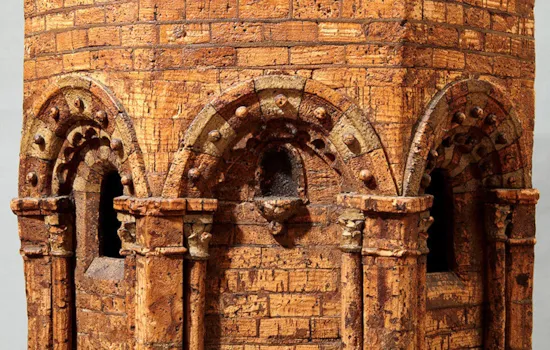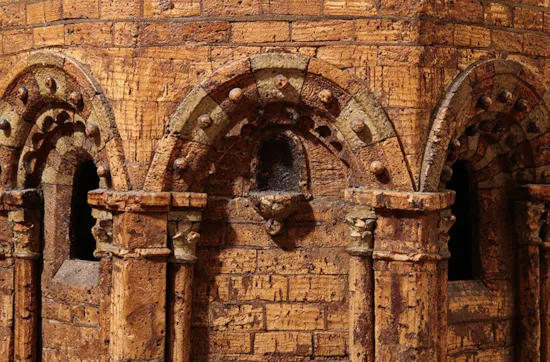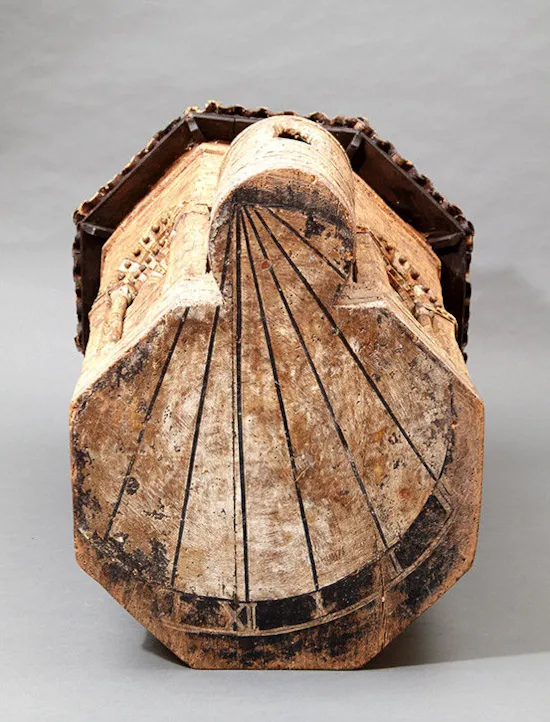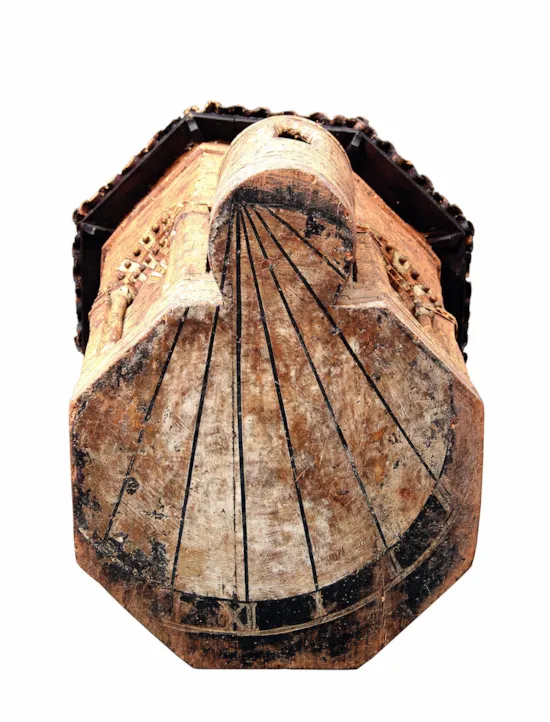Interesting ‘After the Antique’ Architectural Cork Model of the French Romanesque Chapelle Saint Clair in Aiquilhe Le Puy-En-Velay Haute-Loire known as the ‘Temple de Diane’
An Interesting ‘After the Antique’ Architectural Cork Model of the French Romanesque Chapelle Saint Clair in Aiquilhe Le Puy-En-Velay Haute-Loire known as the ‘Temple de Diane’
The initials ‘P.O.’ carved into the cork each side of the doorway
The underside painted with a directional dial and Roman numerals
Late 18th Century
Size: 92cm high, approx: 58cm dia. (max) - 36¼ ins high, approx: 22¾ ins dia. (max)
The initials ‘P.O.’ carved into the cork each side of the doorway
The underside painted with a directional dial and Roman numerals
Late 18th Century
Size: 92cm high, approx: 58cm dia. (max) - 36¼ ins high, approx: 22¾ ins dia. (max)
The ‘Rocher d’Aiquilhe’, a vertical outcrop of volcanic breccia 80 metres high, is surmounted by a chapel and at its foot stands the octagonal 12th century chapel of Saint Clair, the Temple of Diana. The Romanesque chapel was probably built by the Templars upon an earlier Roman edifice. Two hundred and sixty seven steps ascend from the chapel to St Martin-d’Aiquilhe, a 10th century oratory with noted Romanesque sculpture. The town of Le Puy-En-Velay is one of the most curiously sited in France, high lying and set amongst a denticulated landscape of volcanic caves. Its name is derived from the Roman term for the hill ‘Podium Aniciense’ upon which it stands and where once an ancient temple dedicated to Jupiter stood. This was replaced by a church, now a cathedral, that contains a venerated blackened image of the virgin which attracted medieval pilgrims including many popes and crowned heads from all over Europe.
The tradition of making architectural models began in 16th century Italy where scale models were commissioned for strategic military and engineering purposes. By 1780 there were several documented artists working in cork serving the growing interest into the study of the ancient world by ‘Grand Tourists’. Detailed drawings, measurements and sketches were made of many archaeological sites and excavations and this led to their recreation as three dimensional architectural models. Cork was a natural choice as its softness lends itself to being worked in fine detail and can produce the effect of the worn and weathered stone of ancient edifices. It was also readily available as a material in southern Europe and so light to be easily transported.
The most famous collection of cork models was formed by Sir John Soane over the course of his lifetime. One hundred and twenty one models were displayed after his wife’s death in her former bedroom. After Soane died in 1837 his house became a museum and the model room was dismantled and converted into an apartment for the curator. However, through careful study of period drawings and watercolours the model room was reassembled and re-opened to the public in 2015.
The tradition of making architectural models began in 16th century Italy where scale models were commissioned for strategic military and engineering purposes. By 1780 there were several documented artists working in cork serving the growing interest into the study of the ancient world by ‘Grand Tourists’. Detailed drawings, measurements and sketches were made of many archaeological sites and excavations and this led to their recreation as three dimensional architectural models. Cork was a natural choice as its softness lends itself to being worked in fine detail and can produce the effect of the worn and weathered stone of ancient edifices. It was also readily available as a material in southern Europe and so light to be easily transported.
The most famous collection of cork models was formed by Sir John Soane over the course of his lifetime. One hundred and twenty one models were displayed after his wife’s death in her former bedroom. After Soane died in 1837 his house became a museum and the model room was dismantled and converted into an apartment for the curator. However, through careful study of period drawings and watercolours the model room was reassembled and re-opened to the public in 2015.
NOW SOLD - Similar Cork Models always required for stock - please contact with details
Interesting ‘After the Antique’ Architectural Cork Model of the French Romanesque Chapelle Saint Clair in Aiquilhe Le Puy-En-Velay Haute-Loire known as the ‘Temple de Diane’

SOLD
































YOU MAY ALSO LIKE


